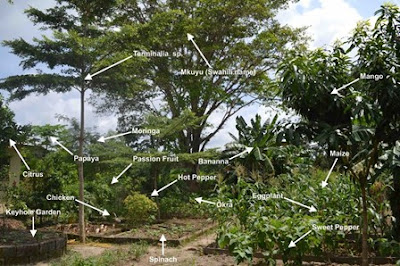PDC LESSON 6.11 COMPANION PLANTING IS POLYKULTURE Part -1-
PDC LESSON 6.11 COMPANION PLANTING IS
POLYKULTURE Part -1-
Companion planting is a form of polyculture.
Companion planting in gardening
and agriculture is the planting of different crops side-by-side for several different
reasons, including pest control, pollination, providing habitat for beneficial
insects, maximizing space utilization, and otherwise increasing plant
productivity.
Companion planting is used by
farmers and gardeners in both developed and developing countries for many
reasons. Many of the modern principles of companion planting were present in
forest gardens in Asia many centuries ago and in America thousands of years
ago.
story
In China, mosquito ferns (Azolla
spp.) have been used as companion plants for rice harvesting for at least a
thousand years. They harbour a cyanobacterium (Anabaena azollae) that fixes
nitrogen from the atmosphere, and they block light from plants that would
compete with the rice.
Companion planting was practiced
in various forms by the indigenous peoples of the Americas before the arrival
of Europeans. These peoples domesticated squash 8,000 to 10,000 years ago, then
corn, then beans, forming the agricultural technique of the Three Sisters. The
corn stalk served as a trellis for the beans to climb on, the beans fixed
nitrogen, which benefited the corn, and the broad leaves of the squash provide
ample shade for the soil, keeping it moist and fertile.
practice
More recently, beginning in the
1920’s, organic farming and horticulture have often resorted to companion
planting because many other means of fertilization, weed control, and pest
control are banned.
The list of companion plants used
in such systems is extensive and includes vegetables, fruit trees, culinary
herbs, garden flowers and forage plants. The number of interactions, both
positive (the pair of species support each other) and negative (the plants are
best not grown together) is also large, although the evidence for such
interactions ranges from controlled experiments to hearsay.
For example, plants in the
cabbage family (Brassicaceae) grow well with celery, bulbous plants (Allium),
and aromatic herbs, but are best not grown with strawberries or tomatoes.
mechanisms
Companion planting can work
through a variety of mechanisms, which can sometimes be combined. These include
pest control, pollination, providing habitat for beneficial insects, and
maximizing space utilization; All of these can help increase plant
productivity.
nutrient supply
Root nodules of legumes fix
nitrogen and support the growth of nearby plants.
Legumes like clover provide
nitrogen compounds to neighbouring plants like grasses by fixing nitrogen from
the air with symbiotic bacteria in their root nodules. These allow the grasses
or other neighbours to produce more protein and thus grow more.
Text from the
roots, Elisabeth Ferkonia (Aus.) PDC studied with Bill Mollison,




Comments
Post a Comment